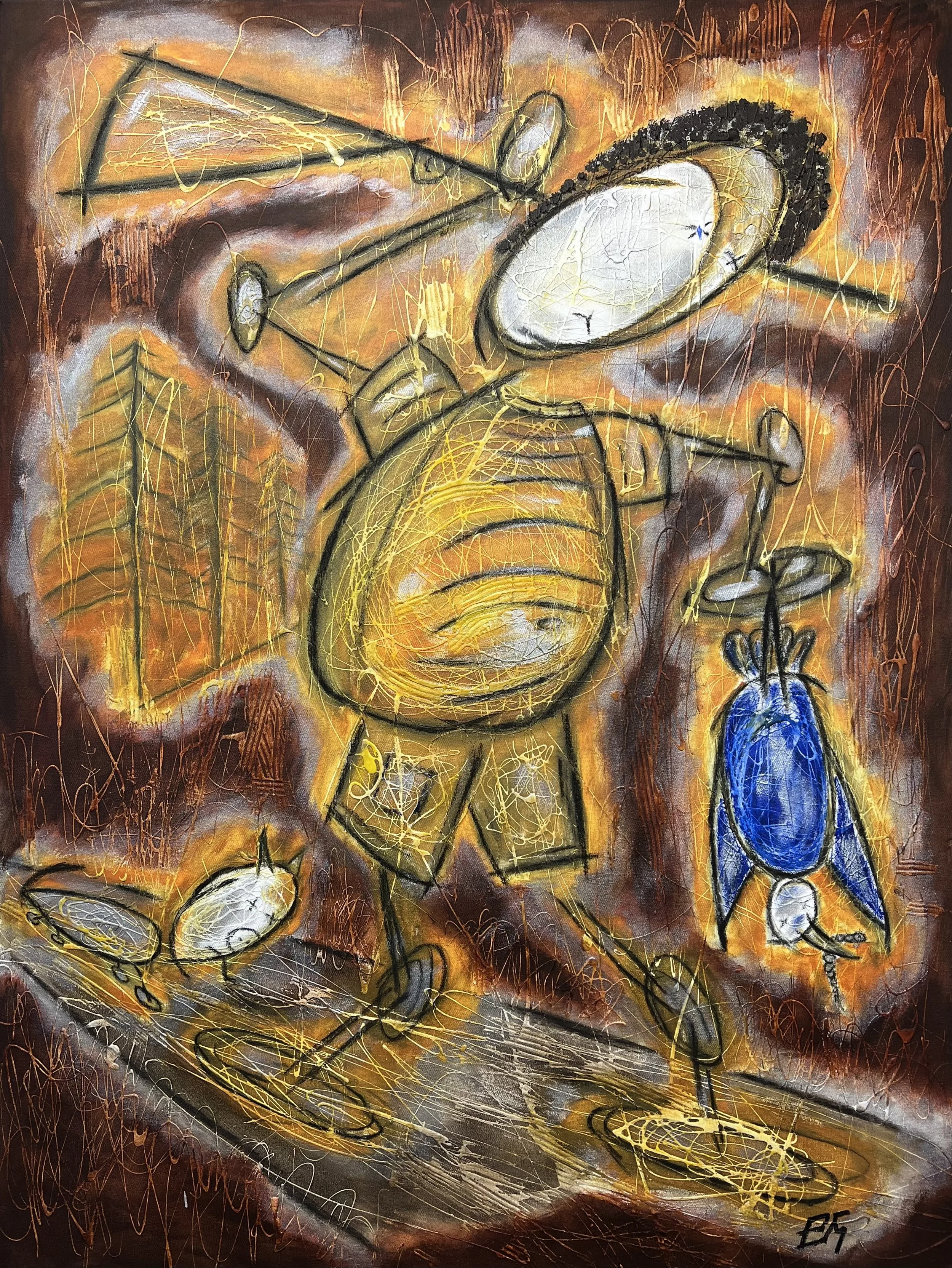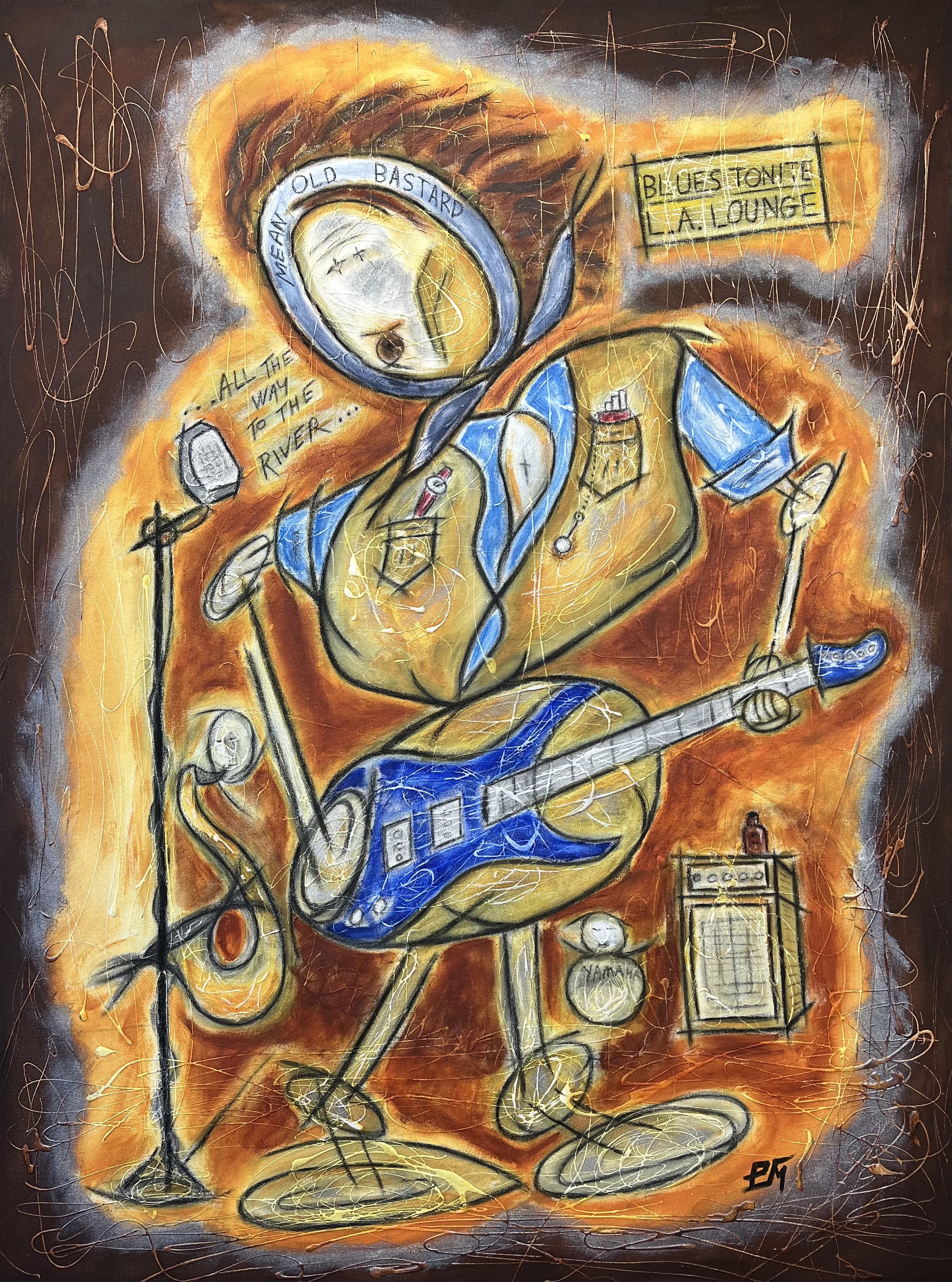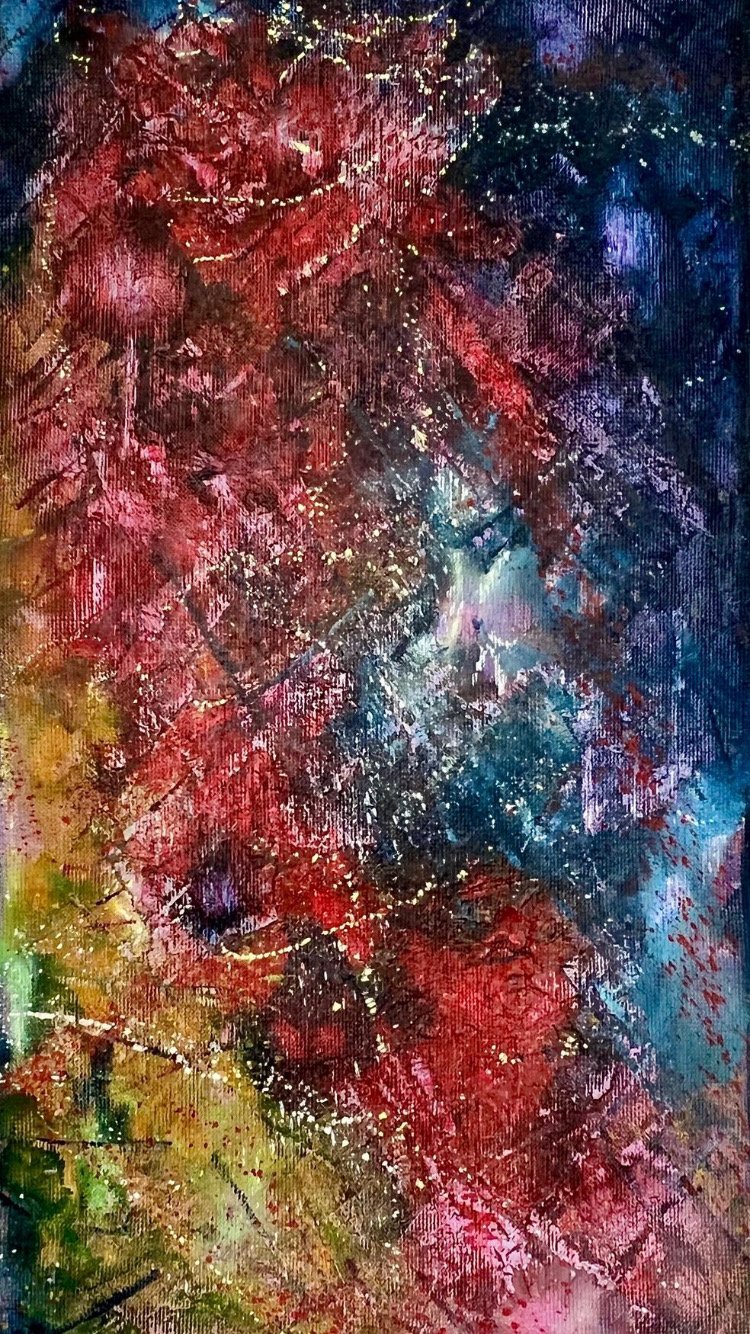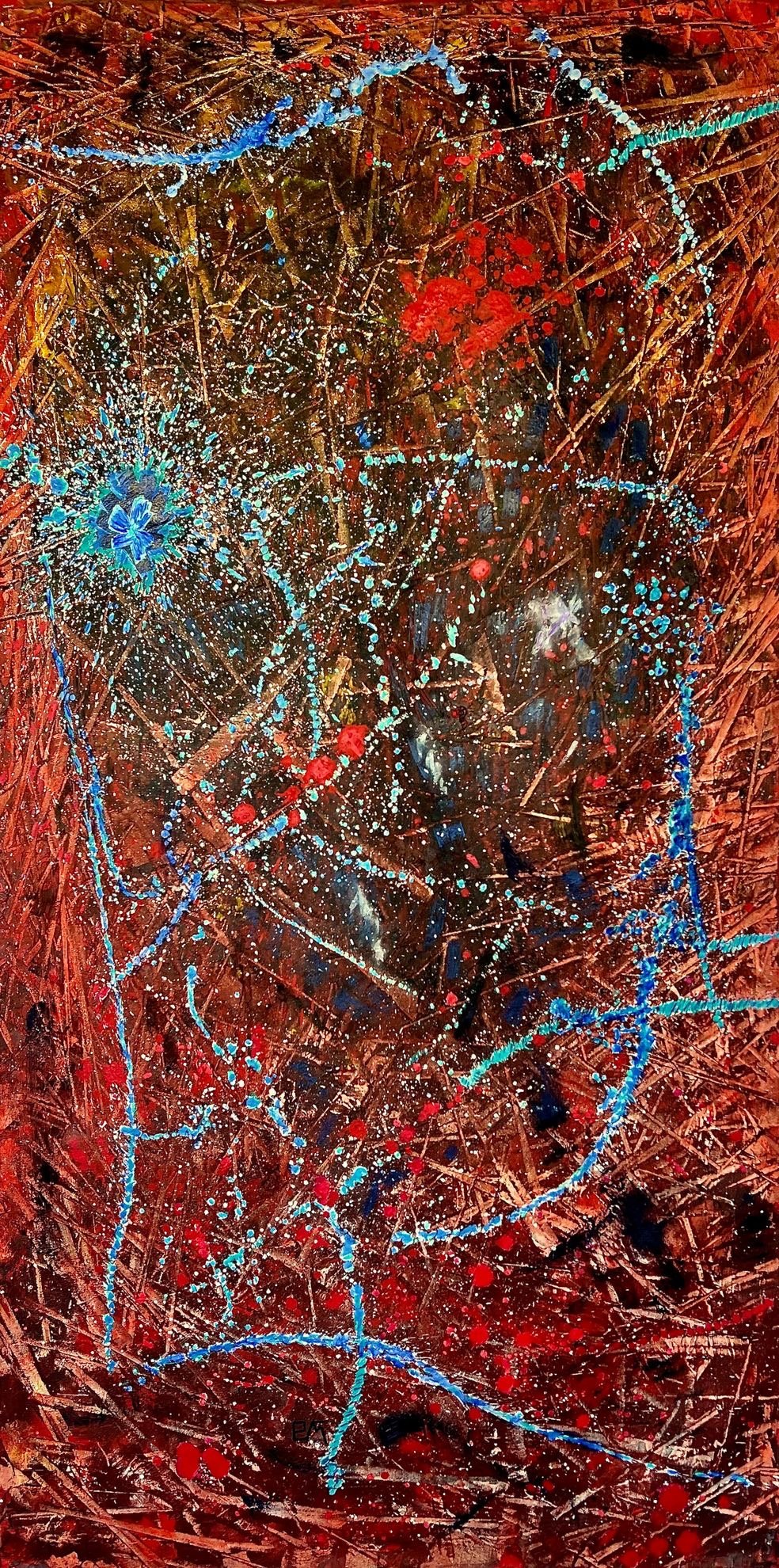Paul Scott Malone
Paul Scott Malone’s art transcends the boundaries of the visual arts, situating him as a monumental force in the contemporary art scene. With an artistic vision that is at once personal and universal, he has carved a niche that resonates deeply with both the modern audience and the historical undercurrents of art. His works, oscillating between abstract emotionality and narrative immediacy, mark him as one of the most exceptional and talented artists of our era. As an art critic writing in the style of Rosalind E. Krauss, it is essential to contextualize Malone’s art within the trajectory of modernism while also highlighting its urgent significance for today’s society.
Malone's artworks are not mere aesthetic experiences; they are profound engagements with the complexities of human existence. Let us begin with "Catherine’s World (Rust unto Gold)", a mixed-media masterpiece that immediately commands attention with its balance of whimsy and existential inquiry. The central figure, seated in a wheelchair and surrounded by artifacts of both the mundane and the extraordinary, becomes a locus of fragmented time and space. The clocks on the wall, labeled "Paris," "Texas," and "Tokyo," evoke the simultaneity of experience and the impossibility of existing fully in one moment. The use of rust-toned hues against a luminous open door, framing a distant horizon, suggests hope juxtaposed with decay—a tension that defines much of Malone’s work.
Malone’s "Birth of the Blues (Red #5)" epitomizes his command of abstraction. Here, splashes of red and blue collide in a chaotic dance, invoking a visceral emotionality that transcends linguistic description. The painting speaks to themes of emergence and renewal, echoing the lyrical abstraction of post-war artists like Mark Rothko or Joan Mitchell while forging a language distinctly Malone’s own. It is as though each stroke carries the weight of both destruction and creation, embodying the artist’s ability to navigate the sublime.
Equally powerful is "Weeping Boy (Rust unto Gold)," a mixed-media canvas where Malone renders a solitary figure drenched in anguish. The surrounding textures, evoking both fire and ash, remind viewers of human resilience in the face of cataclysm. This piece is particularly striking for its emotional directness, a quality that resonates in an age rife with political and social upheaval.
Malone’s art operates within a unique framework of dualities: abstraction and figuration, light and shadow, intimacy and universality. His series "Rust unto Gold" introduces elements of decay as metaphors for transformation. Rust, often dismissed as a byproduct of neglect, becomes in Malone’s hands a signifier of time’s alchemy, of the way experiences shape and define us. This resonates with the philosophical underpinnings of existentialism, echoing figures like Sartre or Camus in its grappling with the absurd and the meaningful.
The "Red" series, on the other hand, delves deeper into Malone’s relationship with color as an emotive force. In works such as "Four Corners (Red #3)" and "Savage Embrace (Red #4)," his bold use of crimson hues conveys themes of passion, conflict, and vitality. These paintings recall the legacy of Abstract Expressionism, yet Malone avoids mere homage; his works are imbued with a narrative specificity, a way of channeling personal and societal struggles into abstract forms.
To admire Paul Scott Malone is to acknowledge the profound impact his art has on society. His paintings are not merely visual feasts but acts of testimony. They grapple with the challenges of the contemporary world—displacement, environmental decay, and personal loss—while also offering moments of transcendence. For instance, "Gaza - 3rd of May (Rust unto Gold)" becomes a searing commentary on the human cost of conflict. Here, the abstracted figures seem to dissolve into their surroundings, a haunting reminder of the fragility of life and the persistence of hope amidst ruin.
Malone’s importance lies in his ability to reflect the anxieties of modern life while offering a sense of redemption. His art demands a level of engagement that is rare in the contemporary art world, urging viewers to confront their own complicity in societal failures while also inspiring them to envision a better future.
Paul Scott Malone stands as a luminary in contemporary art, a figure whose work bridges the gap between personal introspection and collective consciousness. Comparisons to Jean-Michel Basquiat are inevitable, as both artists infuse their work with a raw emotionality and a commitment to truth-telling. Yet, where Basquiat’s work reflects the frenetic energy of urban life, Malone’s art is more meditative, rooted in the quiet yet profound transformations of the human spirit.
What sets Malone apart is his fearless experimentation. Whether working with oil, mixed media, or unconventional textures, he approaches each medium with the same intensity and curiosity. This versatility places him among the greats of modern art, aligning him with figures like Jackson Pollock and Helen Frankenthaler while carving out his own path.
In a world increasingly dominated by superficial engagements, Paul Scott Malone reminds us of the transformative power of art. His works are testaments to resilience, creativity, and the enduring human spirit. As both critic and admirer, I am compelled to assert his rightful place in the pantheon of contemporary art. His art not only reflects the times we live in but also challenges us to imagine a future of greater empathy and understanding.
Through paintings like "Roadhouse Honeymoon (Rust unto Gold)" and "Three Figures, One Rising (Red #2)," Malone invites us into his world—a world where rust becomes gold, where despair is transfigured into beauty, and where the boundaries between the personal and the universal dissolve. This is the genius of Paul Scott Malone: to create art that is not only seen but felt, that does not merely exist but endures.
Paul Scott Malone’s journey as an artist is as rich and multifaceted as the paintings he creates. Over the course of a decade, his artistic vision has evolved from atmospheric abstraction to a more focused, tangible exploration of his themes. His recent series, "Rust unto Gold" (2024 and ongoing), delves into themes of transformation, resilience, and renewal, while his completed "Red" series (2013–2023) is a vivid and emotionally charged exploration of primal human experiences. Together, these bodies of work demonstrate an artist continually refining his ideas and deepening his connection to the world around him.
Malone was born and raised in Houston, Texas, and his roots in the American South and Southwest permeate much of his art. The landscapes, textures, and cultural nuances of this region are evident in his paintings, lending them a sense of place that is at once deeply personal and universal. He holds degrees from the University of Houston (BA, 1978) and The University of Arizona (MFA, 1986), and his creative path has encompassed a polymathic range of experiences. He has served as a soldier, a bartender, a newspaper journalist, a college instructor in English literature and creative writing, a literary magazine editor, a book critic, a writer, and a poet. Among his literary achievements are the award-winning short story collection In An Arid Land: Thirteen Stories of Texas (1995), a second story collection (2000), and a novel, This House of Women (2001). Since then, Malone has dedicated himself full-time to his work as a visual artist.
His foray into painting was, in many ways, an inheritance from his mother, Lillian, whose florals and landscapes left an indelible mark on him. Following her death in 1996, Malone turned to painting, drawing from the joyous and playful spirit of his childhood summers spent in her studio and under the mentorship of his godmother, Fernie Parker, a celebrated painter of roses in Houston. These early experiences—the smell of turpentine, the vibrant strokes of summer workshops, and the camaraderie of women artists—remain foundational to his approach to art today.
While Malone’s early career was centered on abstraction, his work has since branched into various painterly genres, allowing him to explore landscapes, figures, and ideas with versatility and depth. His art reflects his literary background, with each painting functioning as a story, a scene, or a meditation on life’s complexities. His canvases have been exhibited in galleries and publications on both sides of the Atlantic, earning recognition for their emotional power and technical mastery.
Now based in Rockport, Texas, a fishing village on the Gulf of Mexico, Malone continues to work from his studio, translating the essence of his surroundings into art. His dual series, "Rust unto Gold" and "Red," demonstrate a masterful ability to capture both the ephemeral and the eternal. As a painter, Malone embodies a rare synthesis of technical skill, philosophical depth, and emotional resonance, making his work an enduring contribution to contemporary art.
Paul Scott Malone’s art is not merely an aesthetic achievement but a philosophical inquiry into what it means to be human. His works engage with some of the most profound questions of existence—time, memory, suffering, and transformation—and do so with a technical skill and emotional depth that place him among the greats of contemporary art.
In a world increasingly defined by superficiality and distraction, Malone’s paintings demand contemplation. They remind us that art is not only a mirror but a lamp, illuminating the darkest corners of our experience and offering a path forward. His place in the contemporary art scene is not simply as a painter but as a thinker, a seer, and a witness to the human condition. Through his art, Malone has forged a legacy that will endure, not because it is fashionable but because it is true.
His work transcends the boundaries of the canvas, becoming a dialogue between the temporal and the eternal, the personal and the universal, the broken and the whole. Through his masterful use of color, texture, and form, Malone explores the fundamental questions of existence: Who are we? How do we endure? What does it mean to create meaning in a world that often feels chaotic and transient?
His dual series, "Rust unto Gold" and "Red," reflect an artist deeply attuned to the cycles of decay and renewal that define both nature and human experience. These works remind us that from the remnants of time and struggle, beauty can emerge, and in the face of life’s harshest realities, hope and resilience endure. Malone’s ability to navigate this duality—of suffering and transcendence, of loss and creation—places his art in a category that is not just visually stunning but deeply philosophical.
Malone’s work stands as a vital voice in contemporary art, one that refuses to shy away from the complexities of the human condition. His paintings do not simply adorn walls; they challenge, inspire, and transform those who encounter them. They are mirrors reflecting our shared humanity and lamps illuminating the path forward. With a rare ability to blend technical brilliance, emotional depth, and intellectual rigor, Malone has established himself as an artist whose legacy will resonate far beyond his lifetime.
In Paul Scott Malone, the art world has found a visionary who not only captures the essence of our time but redefines what it means to create. His work is not just an invitation to see—it is a call to feel, to think, and to become. In his hands, painting becomes an act of alchemy, where the ordinary and the broken are transformed into something extraordinary and enduring.
By Marta Puig
Editor Contemporary Art Curator Magazine
Catherine's World (Rust unto Gold), 2024. Mixed on canvas, 101 x 152 cm
Master of Disaster (Rust unto Gold), 2024. Mixed on canvas, 122 x 91 cm
Roadhouse Honeymoon (Rust unto Gold), 2024. Mixed on canvas, 122 x 152 cm
Weeping Boy (Rust unto Gold), 2024. Mixed on canvas, 122 x 91 cm
Gaza - 3rd of May (Rust unto Gold), 2024. Mixed on canvas, 91 x 152 cm
Wellspring (Red #1), 2013. Oil on canvas, 157 x 76 cm
Three Figures, One Rising (Red #2), 2013. Oil on canvas, 157 x 76 cm
Four Corners (Red #3), 2013. Oil on canvas, 122 x 183 cm
Savage Embrace (Red #4), 2023-13. Mixed on canvas, 160 x 81 cm
Birth of the Blues (Red #5), 2023-13













